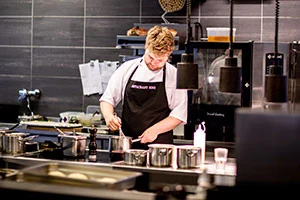
Catalogs
Latest Release
8 Ways to Make Restaurant Kitchen Run More Efficiently
The kitchen serves as the efficiency hub of a restaurant. An efficient kitchen is designed to enable employees to work consistently and efficiently, with everyone strictly adhering to operational standards within their respective roles. Processes such as receiving, storing, prepping, cooking, plating, and cleaning seamlessly interconnect, thus reducing preparation time and enabling timely order fulfillment.
Whether you are to establish an efficient kitchen or optimize an existing one, these summarized by Chefmax, based on years of rich experience in the commercial kitchen industry, will assist you.
Table of Contents
1. Menu Evaluation
One always needs to consider the menu, which acts as the connecting link between the front-of-house and back-of-house operations. The more diverse the dishes your restaurant offers, the greater the need for ingredients and staff.
Reducing the menu is the simplest method, alleviating the pressure of inventory management and streamlining kitchen processes. You can decide which dishes to keep or remove based on business conditions and staff feedback. After considering factors like poor sales, ingredient perishability, and complex cooking procedures, you can remove items that are not effectively promoting your business.
2. Optimize Efficient Kitchen Layout
An appropriate efficient kitchen layout, tailored to your kitchen's size, shape, and restaurant type, is crucial for achieving efficiency, safety, and waste reduction. There is no one-size-fits-all format for ideal commercial kitchen layouts. Here are some classic layout types based on various case studies for reference:
A. Assembly-Line Layout
Workstations are aligned in a simple sequence, with kitchen equipment arranged in a continuous line. Ingredients move from retrieval to preparation, cooking, and plating in a streamlined process. Storage and cleaning areas are situated behind or to the side of the assembly line, ensuring unobstructed workflow.
Pros: Maximum efficiency and effective communication.
Suitable for restaurant types: Those requiring mass production of similar foods, fast service, or a limited range of dish types. Examples include fast-food restaurants and pizzerias.
B. Island Layout
In the center of the kitchen, the cooking area is equipped with gas stoves, fryers, and grills. The surrounding areas are dedicated to storage, prep work, and dishwashing, organized in the order of service. The overall layout forms a circular configuration around the central cooking island, promoting clear zoning and facilitating staff communication.
Pros: Easy tracking and interaction, simplifying communication, with ample open floor space that is easy to clean.
Suitable for restaurant types: Kitchens with square or spacious layouts, adaptable to other shapes, particularly suitable for European-style restaurants (European equipment often designed for modular integration).
C. Regional Layout
The kitchen is divided into distinct areas to prepare different dishes, such as soups, fried foods, and stir-fries. Each area has a dedicated chef, and the central area remains open for staff movement.
Pros: Clear zoning allows multiple tasks to run simultaneously, preparing different dishes, and facilitating management.
Suitable for restaurant types: Restaurants with extensive or diverse menus, such as hotel restaurants and catering services, typically require large kitchen space to avoid overcrowding.
D.Single-Wall Layout
Resembling a household kitchen layout, it involves placing commercial kitchen equipment along one long wall in the order of service. The front space on the other wall side can be left open or used for simple shelving or display screens.
Pros: Space-saving layout.
Suitable for restaurant types: Small eateries with limited space and staff, such as snack shops and food trucks.
3. Establish Efficient Workstations
Fermenting the dough at a constant temperature and humidity is very important for the quality of the baked products. The door of the proofing cabinets is usually designed as a transparent glass door, which allows you to observe the state of fermentation of the dough at all times.
The higher-end proofing cabinets now have additional refrigeration and appointment scheduling features: you can make the dough the night before, set the refrigeration mode and the time to start fermentation, and this industrial bakery equipment will store the dough at refrigeration temperature and start heating and fermenting at the set time (imagine seeing the wonderfully fluffy dough when you start working in the morning).
A. Workstation Connectivity
In a efficient kitchen, the primary sequence of services involves storage, preparation, cooking, plating, and cleaning. The design of these areas should adhere to the following principles:
- Cooked dishes should be positioned near the exit, allowing staff to retrieve and send them out without any obstruction.
- Storage and preparation areas should be situated on the side farthest from the serving door, making it convenient to retrieve ingredients for immediate processing and avoiding blockage of other processes.
- Storage and cleaning areas should not be positioned too close to each other to prevent contamination of stored ingredients with used utensils or cleaning agents.

B. Organized Placement
- Arrange workstations for shared menu components adjacent to each other based on menu requirements, minimizing the distance chefs need to move when preparing multiple dishes simultaneously.
- Keep tools such as knives, bowls, and spoons consistently placed in designated areas to maximize staff efficiency, ensuring easy retrieval and return.
4. Upgrade Equipment
Commercial kitchen equipment has a direct impact on preparation speed and cooking efficiency. Older kitchen equipment inevitably slows operations, leading to longer and more frustrating wait times. Whether you intend to purchase new equipment or need to upgrade existing ones, you can evaluate them based on the following aspects.
A. Speed
Kitchen appliances designed for more efficient and rapid operations can have a positive influence on kitchen performance. For example, highly efficient continuous feed processors can batch-chop food or condiments, saving nearly half the preparation time. The fastest dishwashers can clean a basket of tableware in just one minute. High-capacity gas ranges also reduce cooking times. The time saved can provide your efficient kitchen with a competitive edge.

B. Automation
With the rise in labor costs, the preference for automation equipment that saves labor and ensures consistency has increased. Commonly used equipment includes ovens, fryers, pasta cookers, dishwashers, and stir-fry machines.
Opting for highly automated equipment may reduce labor costs and errors, although they are typically more expensive. Automation extends beyond usage. If the unit includes automatic cleaning and self-draining processes, it can also save cleaning time and labor.
C. Consider insulation
Insulation equipment, such as strip warmers and countertop steam tables, keeps meals and soups at the right temperature without compromising quality while waiting for orders. You don't have to reheat or prepare soups upon receiving orders, significantly reducing service time and increasing efficiency.
5. Precise Inventory Management
Inventory management is a crucial aspect of efficient kitchen management. Its significance lies in maintaining a smooth supply flow, reducing waste, and contributing to overall profitability. Inventory management does not demand absolute accuracy 2%-5% margin of error falls within an acceptable range. Manage your inventory easily by following these four tips:
- Avoid over-purchasing items and minimize inventory levels. That is especially true if demand is low or perishable.
- Implement expiration date labeling and utilize items before they expire.
- Adhere to the first-in, first-out (FIFO) principle, using older items before acquiring new ones of the same type.
- Standardize the usage of ingredients in recipes, which not only aids in flavor consistency but also facilitates precise consumption calculations, helping keep waste within reasonable limits.
6. Modify Based on Employee Feedback
During busy times, certain areas may become crowded, some preparations may lack time for completion, and some equipment may exhibit low efficiency. Chefs are the individuals most familiar with kitchen conditions, and their practical experience is invaluable in identifying issues.
Employee development is also beneficial for enhancing kitchen efficiency. When employees become proficient with equipment usage, know how to quickly locate needed items, or suggest improvements based on their experience, the entire team grows more effectively. You can gather insights into each employee's development status by conducting staff meetings, collecting written reports, or administering surveys.

7. Preparing Ingredients in Advance
The busiest times of the day can leave your staff feeling overwhelmed, which results in reduced efficiency. The best solution is to prepare in advance. While maintaining the freshness of ingredients is crucial, the efficient kitchen can benefit from a streamlined process by preparing some food and ingredients ahead of time.
Here are some tasks your kitchen can undertake before peak periods: preparing sauces and soups, cleaning vegetables and fruits, peeling carrots or potatoes, chopping ingredients, and ensuring that necessary tools and seasonings are readily accessible.
8. Continuous Cleaning
Cleaning may seem like a task at the end of the day, but it's not. Every staff member needs to cultivate a habit of continuous cleaning, which is the simplest way to prevent work disruptions caused by clutter. Cleanliness is also a reflection of an efficient kitchen.
- After using the equipment, perform a quick clean, making it ready for the next person to use promptly.
- Maintain a clean workstation to ensure that tools and utensils are securely placed on the countertop.
- Timely clean any oil spills, water stains, and vegetable peels on the floor to guarantee everyone's safety.
- Keep shelves and cabinets organized; nobody wants to search for tools or seasonings during busy periods.

Conclusion
Establishing an efficient kitchen is an ongoing process where you continuously identify and address issues. Chefmax is dedicated to supporting the development of efficient kitchens of all types, offering comprehensive kitchen equipment solutions. If you have any questions, contact us for professional and complimentary assistance.
